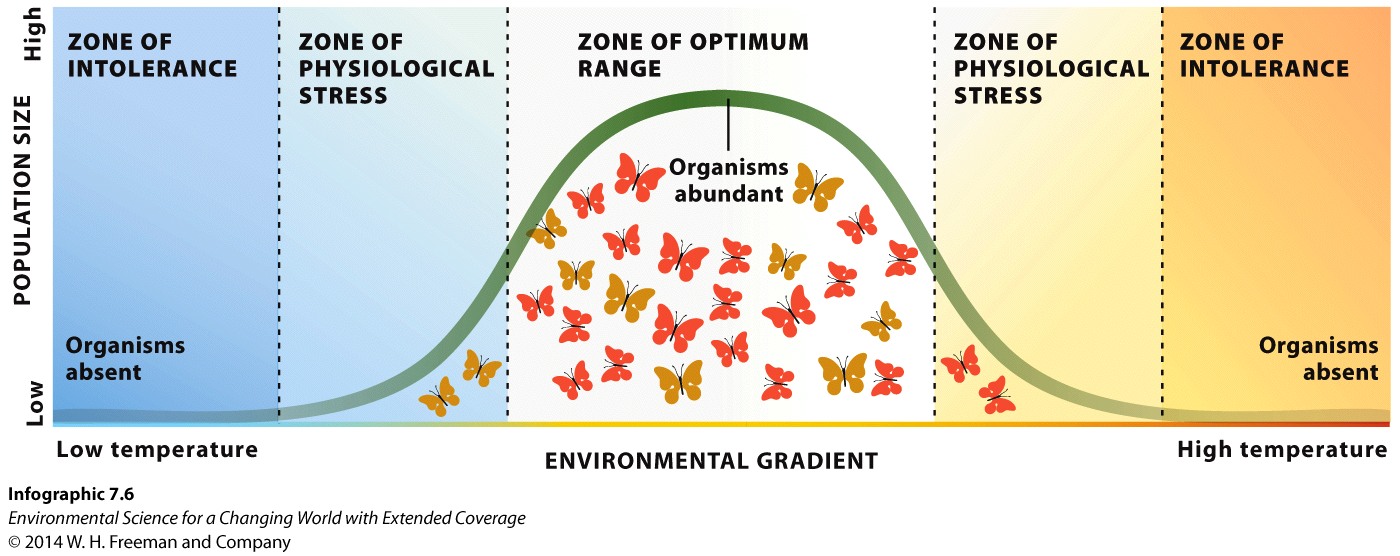Chapter 7. Chapter 7: Ecosystems and Nutrient Cycling
What are tolerance limits...

Guiding Question 7.3
What are tolerance limits, and how do they affect the distribution of a species within its ecosystem?
Why You Should Care
Tolerance ranges impact your daily life already. For example, excessive levels of suspended particles, nutrients, and pollutants in fisheries like the Chesapeake Bay have led to the collapse of important fisheries. With global climate change apparently at hand, ecologists are concerned about how changes in temperature, rainfall, and severe storms will affect organisms and ecosystems. Understanding tolerance limits makes predicting future trends and potential issues more accurate.
Question Test Your Vocabulary
Fill in the blank with the correct term to match the following definitions:
The range, within upper and lower limits, of a limiting factor that allows a species to survive and reproduce is known as the RlS63AfLjuJOlWfKw76EKoaiYp4o2R/b.
The critical resource whose supply determines the population size of a given species in a given biome is known as the q55C+U//mBpeCJ8qQqDHYvIAaXk=.
Question Sequence
Question 7.1
iUbtqXTYOMYnVMsN38hbRdNQ7x8IpILFSU3Axj04q9gLLGF88YAgzBxuuD2+Q+wChXG27ixPDBL1utlX8Y7Filc61Y/5OJaU8H1M6rV0rOAXr8eG21RLwvsiA+5ePRyNA8kP5p0x6zY0MQEsImwJL7An/z4FZ9A5d9pGnjeL3nGlVVh55N2fiNhUJE3oXihCB+KiMya4CALi40fH6F9oxD8VCHIAzRR54RxrxriY7qEUU21nm/CgtjjXO/YPgPic/a+xl2OmPBv9yxTxZYGja5r2LhJfBLo+J3XAhdrWIvbNUdXN1liLfOHIJ5bZyEKyQB71vhdxjxGgbHmDQuestion 7.2
VjcUHAHr2nYo0koP246lb6NcnQ/9FawZJwXjZKh495yNzV3FRujETKlYkP3oPTGxpDqJ9OXmg0Chvxl2WwhToov4S+6r8E8G2sDh+i9Ayw3ZkfY+JFouZrxwnl9Xz6aa2iLij10847Qf7okDmX8s/AB3uZO9d8fykdtPxnLic+SVN1QqPU0cNUYDjRQ9ceuMXKlF43xxS3HaWpB8Jw+gzu/dZXBVkXmRyw3XoK5Y201vjss1T6w8gUF4RDBM91PTH3vyeZiZ4sbe8QurU1LGq0L4TFR00Tv2Iqfd/ftqnagZePHIbL0ZmOJZPTtVCCr2fqC9nDy4jvx7BOgWycgRjfupFP70aPh3gw26twz5Gj9YLQAT2JitH3jWzvXC341JjEmI+AquieBpm4BDKbucibxL6hhFRzVY3+k3J7szFmhg+QkwmRKSHaktelN9o0av21XM4d5FmGmJGIOXKoSBnVd08gCCUetT85XxgLZIJj2sqaPRaLmyKaFqOqJpmjSds5tpuSY1uC1W9ttuwLw8zpWpTBAzmwzZ9fr9duCx3BYnfzVMas0h+sbdxSBZLPBzcK06hfSWNJxPMseagyChGpYgKc2hDbgld0J5hzpb+7J1dXM8DcDOoU+TaIZHKPp9W8VCLQ==Question 7.3
A plant nursery wants to know the optimal soil pH needed to grow a popular species of annual flower and conducts a trial of germination rates at different pH levels. Based on your interpretation of the graph below, what is the best soil pH for growing these plants?
Question 7.4
p/i3fy4b+K0GzS3Dwacw0saJsmJoBcpGVUdHV1ztmOO0qMP4Awdcpa2H9ply1pPST8Uno3BWmDAOfapLhspmZZJdzr32eS5B9BJcxyHMG3loCOT8y9VLzGMGgDac1LNe8lNqKh2/ITLSJhnk2r++Zw==f Humidity
Oxygen concentration (both in air and water)
Nutrient availability
Fire (some biomes like savannas have organisms adapted to periodic burning)
Question 7.5

Although some butterflies may be able to survive extreme temperatures, not all will be because these temperatures are physically stressful, and population sizes will be smaller at the extreme ends of the range of tolerance.